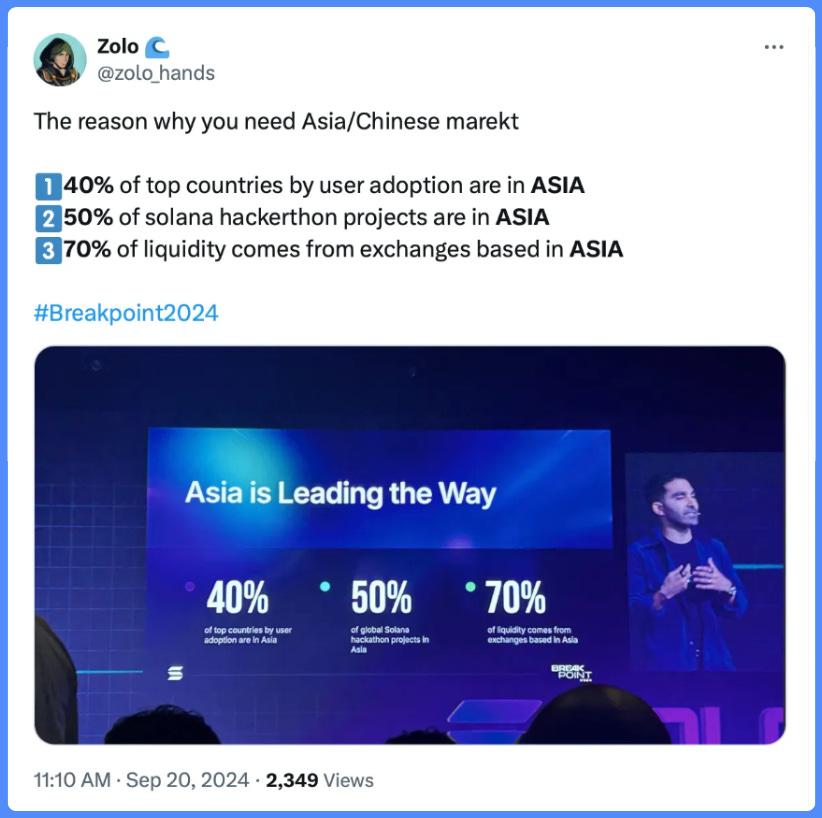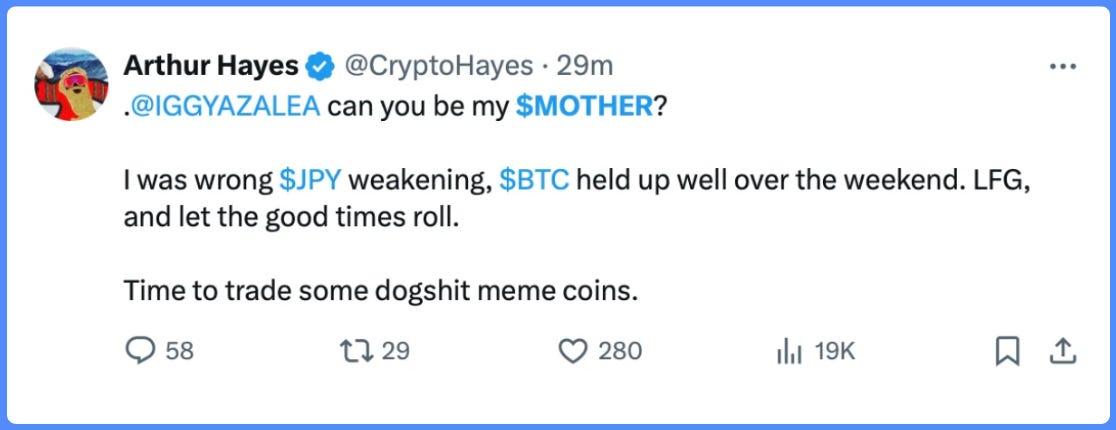Author: Sankalp Shangari, Crypto KOL
Translated by: Felix, PANews
For the past decade, we have been touting the dream that cryptocurrency will fundamentally change the world, solve real-world problems, and welcome a flood of Web2 users into this bold new world. But to be honest, cryptocurrency has not fully delivered on that promise. Instead, we have collectively turned into thrill-seeking Degens, darting through various Ponzi schemes like squirrels on espresso.
This reality was perfectly showcased at the 500+ side events of Token 2049. Project funding is so excessive that marketing budgets exceed actual revenue (if any), and the lavish booths and five-star venues mask the reality of the lowest user adoption rates. Venture capital that once poured billions into anything with a white paper is now silent. The good news? Only serious projects can secure funding now. The bad news? It took the crypto industry this long to get here.
We see over 100 L1/L2s vying for the same crypto audience—lower engagement and fewer meaningful conversations. We’ve shifted from Solana to Ethereum memes, then to Base, and now to Sun Yuchen playing Icarus, dangerously flying toward the sun. (Note: Icarus is the son of Daedalus in Greek mythology, who fell into the sea and drowned when he flew too close to the sun, melting the wax on his wings.) This is great for short-term drama, but where is the long-term vision? Where is the promised mass adoption? Jumping from one meme to another, from one chain to another, is not real business.
Over the years, we have witnessed the hype of ICOs, the DeFi yield farming, the NFT frenzy, the GameFi distribution Ponzi schemes, PoS staking, re-staking plans, and now Bitcoin re-staking (really?), culminating in points and airdrop pyramids. What’s the next gimmick? Everyone I talk to is very concerned about the direction of the industry. A lot has happened, but nothing has materialized.
Venture capitalists are frustrated because they did not anticipate the frenzy of Memecoins, and they cannot touch this space with regulated funds. Founders complain because VCs no longer fund every “weed” in the garden, hoping that one will grow into a “rose.” Degens are tired of jumping from one narrative to another, while Farmers are frustrated that airdrops and points do not bring free wealth (Grass, Eigen, Blast, etc.). The only ones laughing are those involved in trading (CEX, DEX, perhaps), gambling (Rollbit, Shuffle, Polymarket, memecoins), and the infrastructure supporting it all. This is evident in F1 sponsorships, large booths, and millions in marketing budgets.
Meanwhile, as Nvidia stocks provide cryptocurrency-like returns, AI and stocks are becoming the focus, offering higher returns, lower risks, and stricter regulations, with easier access through fiat and simpler user interfaces/user experiences. Smart TradFi money is earning returns from stocks with much less risk (yes, I know stocks have risks, but look at the prospects of cryptocurrency). When you can buy options on MSTR or COIN for exposure, why bother investing in cryptocurrency?

Well, it’s not all doom and gloom. There is still a glimmer of hope at the end of the tunnel. Some talented founders continue to secure funding, and real use cases with actual revenue potential are starting to emerge. Thank goodness, venture capital firms are becoming more selective, and we are seeing more corporate participants, like Sony, global banks, and financial firms, quietly entering the space. But this is not the mass adoption we promised.
So where are the opportunities? Two types of games have emerged in cryptocurrency:
- Short-term narrative-driven (quick in and out). There’s nothing wrong with this, but it’s mainly played by Degens, short-term founders, venture capitalists, and KOLs who hope to get rich quickly.

- Long-term participation by large funds backed by major venture capital firms, supporting top developers and founders, hoping for massive returns from IPOs and potential Solana or future infrastructure.
Thus, while the atmosphere of these activities may feel a bit like a rainy day parade, there are still some outstanding founders, projects, and venture capital firms that may surprise us in the coming years. If Bitcoin reaches $100,000, we will all return to the land of Ponzi schemes faster than you can say “decentralization.” No one will care about the fundamentals—until the market sounds the alarm, and by then, it will be too late.
Always stay “hungry,” stay humble, and stay hedged.
Crypto Audience
1. Crypto Retail Degens (65%)
These newcomers are like enthusiastic puppies chasing every shiny object, mainly looking to catch the next Bonk, WIF, or Poppet and “hope” to quickly exit with their winnings. Their characteristics include:
- Hopeful speculators: Believing they can get rich overnight, they rotate from one memecoin to another like kids jumping from one candy to another at a carnival.
- Freebie enthusiasts: These individuals are mainly interested in booth giveaways, parties, and countless side events promising free drinks and snacks.
- Short-term thinkers: They focus on immediate benefits, often overlooking the bigger picture and the complex games behind the scenes.
- Project builders: Some even attempt to launch their projects, usually funded by like-minded short-term venture capital firms. However, most founders struggle to gain support.
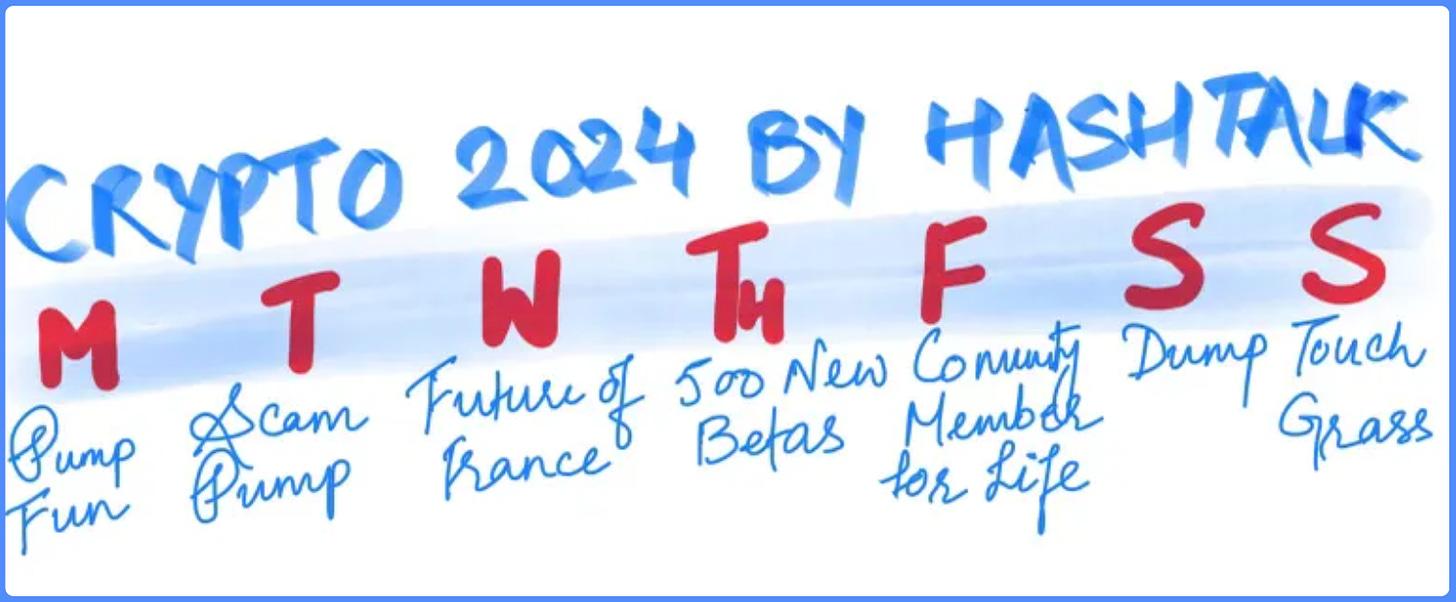
2. “Smart” Developers and Venture Capitalists (25%)
This group is slick, self-proclaimed elites, aiming to emulate figures like Vitalik, Anatoly, or Raj, while peddling their dreams to venture capitalists who are obligated to fund them. Their strategies include:
- Funding first: They prioritize securing funding for the next 2-3 years and create detailed plans to generate buzz through collaborations with KOLs and eye-catching announcements.
- Token hedging: They often fund more project operations and hedge their tokens at the time of listing, planning to gradually sell after cashing out, causing prices to drop.
- Letting others take the fall: If a bear market hits, venture capitalists and retail investors will walk away empty-handed while these founders enjoy hefty salaries and business class travel.
- Long-term vision facade: They disguise themselves as advocates for change until the token issuance, at which point their true intentions are revealed—think of Blast and Friend.tech, and then they will jump into the next Ponzi scheme. There are hundreds of such examples.
3. True Builders (10%)
The final group consists of true dreamers—real “Chads” committed to building “the future of France” (or whatever their vision may be). They embody:
- Smart minds: Not just selling dreams, these individuals focus on creating revenue and adding real value.
- Persistence: While they may initially struggle to gain traction, they remain steadfast, refusing to issue tokens merely for exit liquidity.
- Long-term commitment: They are in it for the long haul, grounded in reality, outspoken, and advocating for the sustainable development of the industry.
In short, these three groups illustrate the range of attitudes in the crypto space—from impulsive Degens to shrewd schemers, and finally to true builders, who may just be the ones leading us toward a brighter future.
L1/L2 and Infrastructure
- ETH Identity Crisis: Ethereum is currently facing an identity crisis—it can be seen as a midlife crisis, trying to buy a sports car while everyone else opts for electric vehicles. With most attention (and development) shifting to Solana and select EVM L2s, many users are downplaying ETH. Ultimately, price is more important than block size. Are ETH thought leaders too comfortable in their mansions to engage with the frontline developer community? Why can’t they become Solana? Is Vitalik the right savior?
- Solana is the clear frontrunner: Solana seems to be strutting down the runway, as if it just won “Best Show.” After the Breakpoint event, discussions around the Solana ecosystem have intensified. They are not just talking; they are delivering products faster than pizza delivery on game nights. Look at Firedancer. The Solana community is very organized, especially compared to the chaotic ETHGlobal events. Solana’s single-chain focus and unified community give them an edge—focus is key.

- TON: The taxi service powered by TADA and TON payments was a huge success at Token 2049. Everyone was using it and passing around TON and TADA referral codes. The marketing efforts of these two companies were truly impressive. TON is a clear contender for the next L1 position, with an internal user base of 800 million and the potential for real mass adoption.
- VC Interest and Funding the Next SOL Killer: VCs continue to flow into the next potential Ethereum or Solana killer. Mathematically, this is a no-brainer: if you can find a project that will yield 1000x returns in the coming years, supporting it is like finding a golden ticket in your chocolate bar. There are over 10 L1s with almost no activity, with trading volumes still between $1 billion and $10 billion. For any VC, this alone represents a massive return.
- Gen Z L1's Seasonal Hotspots: Projects like Monad and Berachain are the latest hot topics, while SUI and Base are also receiving attention. In contrast, older chains like Aptos, SEI, and TIA (Millennial L1s) are losing momentum, while chains from the baby boomer generation like Polygon, Algorand, and Cosmos are quickly fading from view. Of course, we will see occasional price spikes driven by market makers and new narratives (like FTM and AVAX), but these are often fleeting.
- Niche Chain Specialization: We are witnessing a shift towards specific chain niche markets. Solana is used for memes/payments/trading, Ronin for GameFi, and Arbitrum for DeFi. This trend, combined with chain abstraction and cross-chain solutions, enhances user experience and makes interactions smoother.
- Shift to B2B Infrastructure and Service Providers: Some OG chains are offering CDKs, SDKs, rollups, and application chains. While this may keep their tokens relevant, it feels like a band-aid solution—great for yacht life, but not entirely sustainable for the ecosystem.
In summary, while Ethereum struggles with an identity crisis like a teenager unsure of their hairstyle, Solana is charging ahead, fostering innovation and community engagement. As we continue down this path, let’s see how things evolve and which projects truly stand the test of time.
Projects and Founders
- The Harsh Reality of Crypto Financing: Most projects face a slow and painful death in the crypto wilderness. The glory days are long gone, when you could secure funding with a dazzling PPT presentation like a disco ball. Now, it’s like trying to sell ice to Eskimos.
- Funding Cycles: An endless hamster wheel, funded projects aren’t doing much better. They are stuck in the hamster wheel, burning through venture capital money. Once the funds run out or become very low, it’s time to raise more money or launch a token. If the token succeeds, they might survive for another 2-3 years; if not, it’s back to square one. Without new users or actual revenue, the path to profitability is as murky as a foggy night on a desolate road.
- The Rise of New Projects: Old projects are like once-popular toys that no one wants to play with anymore. Why invest in something outdated when SUI, Aptos, Berachain, and Monad are offering grants to attract activity? It’s the same old story, just repackaged—perhaps not even vintage.
- Ponzi Scheme 2.0: Ponzi schemes seem to be sprouting up like weeds after rain. This reminds me of the era of Celsius and BlockFi, when lending spiraled out of control, leading to a stunning collapse. Now, we see similar cycles of staking and re-staking, along with the age-old refrain of “your token generates my token, and we both generate returns”—but this time, the scale is ten times larger, and the chains have increased tenfold. When will it end?
- The Dilemma of Tech Founders: Most tech founders seem unaware that cryptocurrency is a completely different beast. They often fail to realize that token economics, product-market fit, community building, and all these buzzwords are crucial for success. It’s not just about having a great product; you need a massive network and a bit of luck to make it work. If you haven’t joined the right VC gang or “KOL mafia,” good luck.
In short, cryptocurrency is a strategic game, and if you want to play, you better understand the rules—otherwise, you might just end up as another cautionary tale in the wild west of crypto.
Venture Capital Funds
A Year for Venture Capitalists: Navigating the Crypto Swamp.
- Most venture capitalists have had a tough year: they either entered too early, watching their investments struggle, or invested this year only to find the vesting schedule still 12-18 months away. In the crypto era, this is like waiting for a snail to finish a marathon.
- The Smart Few: However, a handful of venture capitalists play the game like chess masters. They help list tokens at high fully diluted valuations (FDV), hedge their risks, and then wait for the tokens to hit rock bottom before buying back at a low price. It’s like buying a beautiful suit on clearance after the fashion show—just know when to hold and when to fold.
- Revenue Race: Most venture capitalists have finally realized that some projects can generate real revenue—like Friend Tech, Pump Fun, and Polymarket. Now, everyone is racing to catch the next wave. What’s the challenge? Picking winners and losers among numerous competitors—there are over 100 alternatives just for Pump Fun. In social events, everyone wants to outdo each other; it’s incredibly crowded.
- Liquidity Dilemma: Liquidity providers are becoming the darlings of the crypto world, as projects desperately need more TVL and capital to successfully launch their tokens. Looking back, it’s hard to ignore that most liquidity funds this year have underperformed Bitcoin—unless they excel at trading memecoins or crypto stocks.
- Memecoins Out of Reach: Regulated funds cannot touch memecoins, and unfortunately, everything this year has been about memecoins.
- LP Interest is Starting to Rise, but they are all waiting for dramatic events to unfold. I’ve been talking to Asian wealth managers and family offices. Interest has emerged after ETFs, but they need a trustworthy party to manage their funds, and they occasionally receive some terrible news/hacks/scams, causing them to hesitate.
In summary, while the outlook is rocky and full of challenges, those with steadfast belief may find a path to success amid the chaos of cryptocurrency.
Narratives
AI projects are standing out, capturing the largest market share. It seems everyone is building a decentralized computing network. Just like everyone is building better TPS L1/L2s.
The most frequently asked question—what do you think the next narrative will be? Everyone wants to build or invest in the next short-term narrative.
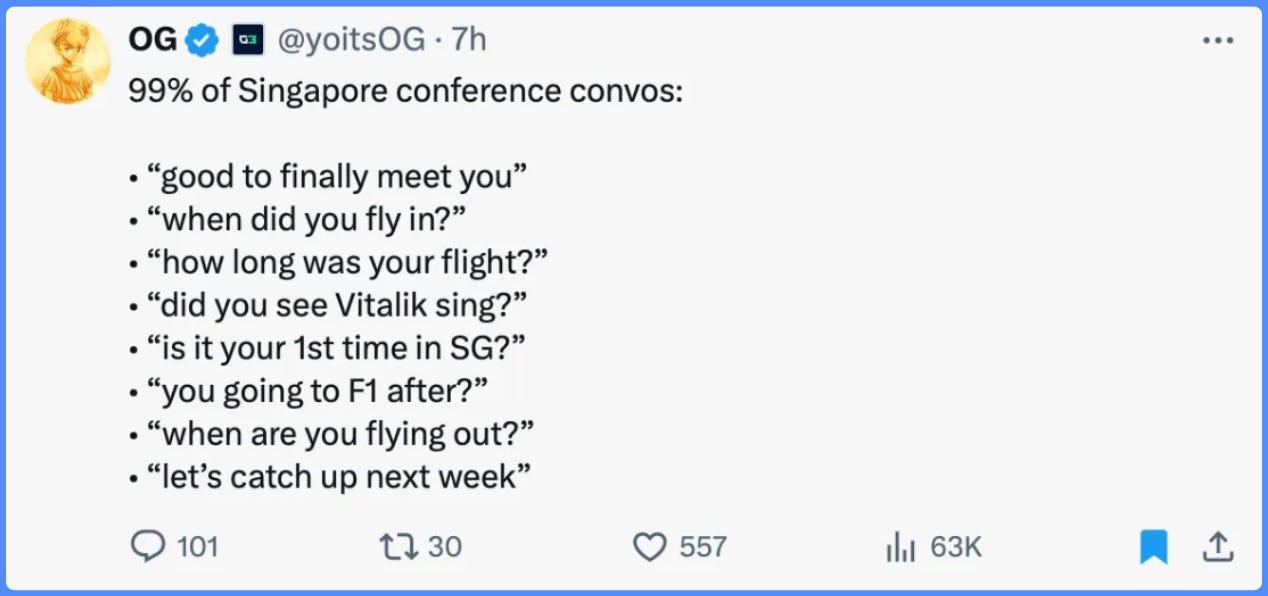
Asia is leading in the crypto space, with as many developers, founders, and venture capital firms as the West. Compared to the West, regulations in Singapore/Dubai/Hong Kong are clearer, and everyone I interviewed wants to enter Asia. The population in Asia is younger, more eager for development, and has a higher adoption rate.
- After GMX, no other Perp DEX has received any favor except HyperLiquid. Everyone is waiting for their launch, with some claiming the FDV could reach $100 billion. This could set the tone for the release and good performance of other innovative Perp platforms.
- RWA seems to be another category of interest for the entire industry. Currently, Helium and Solana appear to be leading the race. Helium is collaborating with telecom companies to allow its signal and share Helium’s coverage, leveraging its expanded home wifi signal. With over 750,000 users, this is an astonishing real-world use case.
- You can’t kill the memecoin frenzy—because we default to being Degens. Memecoins will continue to exist.
- Chain abstraction as infrastructure is very exciting. But there are too many participants and booths at Token 2049. No clear winners have emerged yet, but the use case is clear—multi-chain trading can occur without knowing you’re on a blockchain.
- The Bitcoin ecosystem seems to be slowing down. While there is plenty of activity and buzz, it’s not as prominent as last year. The entire ecosystem still faces chaos, and real use cases and user experiences are still far off.
- Staking and re-staking are losing momentum as too many derivatives appear on too many chains, causing fragmentation and risk across the ecosystem. The typical representative of staking, LIDO, seems to be cursed, and people are starting to move on. I don’t have high hopes for the entire staking/re-staking mechanism, but I’ll keep an open mind if I see anything interesting.
Winners and Losers
SOL is the clear winner, a chain that dominates all chains. ETH follows closely, with TON having similar potential, as mentioned above.
TON and SUI currently seem to have the highest market share among all L1s, with a potential internal audience of 800 million. SUI is about to reach its $25 billion FDV cap, which I believe is the limit.
TAO / Bitrensor is the most watched project and one of my favorites in AI. It is the clear winner in its category. Render is another favorite project.
When CZ comes out, Binance may undergo a makeover. But BSC needs to create memes like Justin, rather than launching the wrong "Neiro."
$Mother has created a huge buzz in the memecoin space, and I believe Izzy has been driving this process her way. [
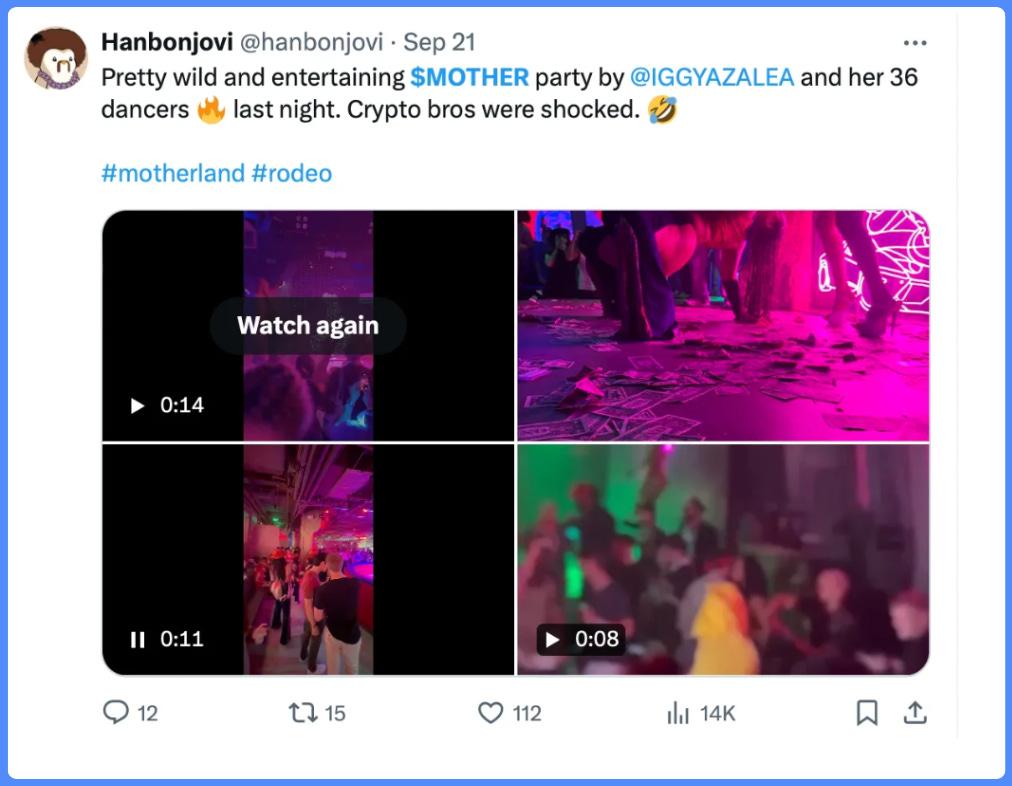
](https://x.com/hanbonjovi/status/1837431381657604538)
Hyperliquid is gaining popularity. With a smooth user experience, it is quickly becoming the preferred exchange for many. Some love it, some hate it. It’s hard to predict how it will perform initially, but it’s worth keeping a close eye on.
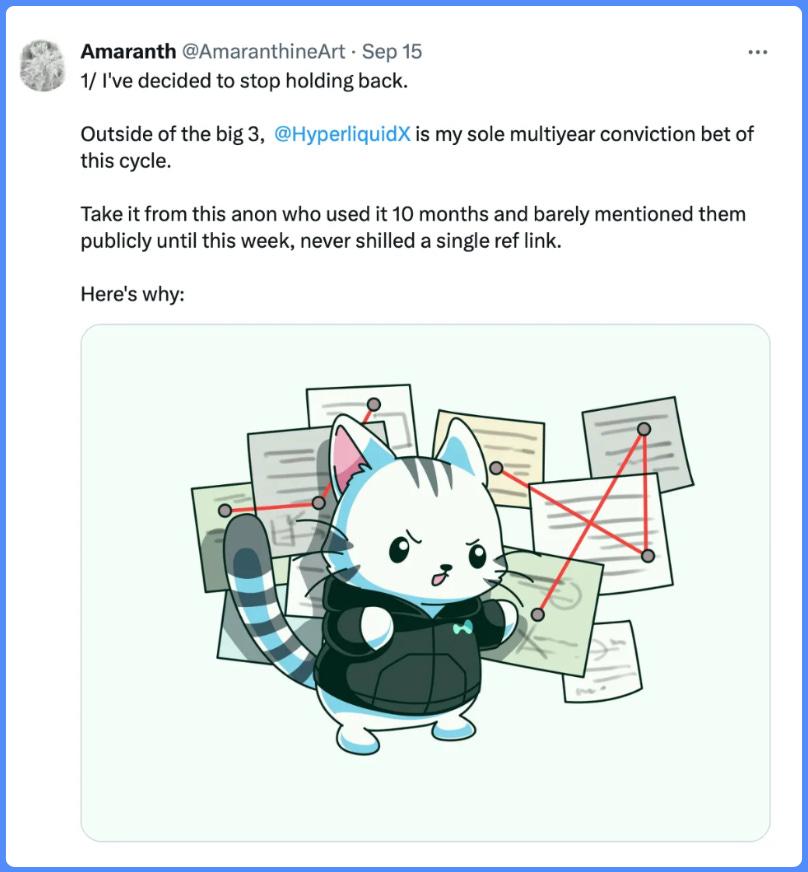
Liquidity for new projects will become an issue: Over 40 excellent projects are set to launch in the fourth quarter, with more than 100 projects on the sidelines. We are talking about over $20 billion in new FDV. Who will buy them? If people are to purchase Monad and Berachain, they must sell off the Millennial and Baby Boomer L1s. I believe there isn’t enough liquidity. Many projects and their communities will suffer greatly.
GameFi has yet to gain momentum: People seem uninterested in GameFi. However, I believe GameFi will revive at some point.
Related reading: Token2049 Short Essay Collection: Pessimists are Exiting, Optimists Will Ultimately Prevail
免责声明:本文章仅代表作者个人观点,不代表本平台的立场和观点。本文章仅供信息分享,不构成对任何人的任何投资建议。用户与作者之间的任何争议,与本平台无关。如网页中刊载的文章或图片涉及侵权,请提供相关的权利证明和身份证明发送邮件到support@aicoin.com,本平台相关工作人员将会进行核查。
